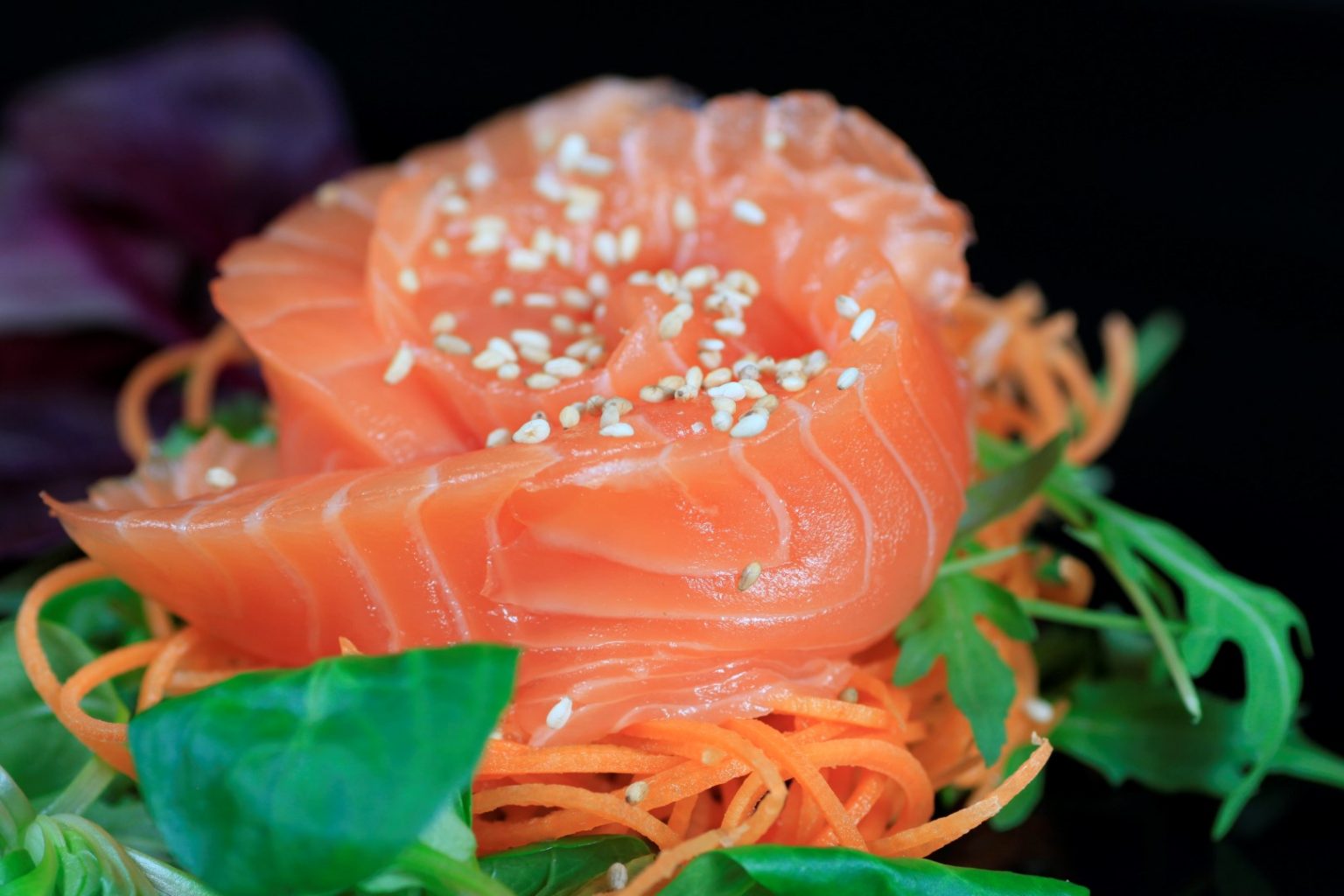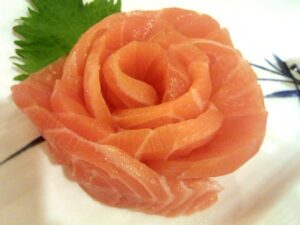Salmon sake often simply called sake refers to salmon that is commonly used in sushi and sashimi. With its bright orange-red color, smooth texture, and rich flavor, it has become one of the most beloved fish for raw fish dishes. But what exactly is salmon sake? Where does it come from and how is it used in Japanese cuisine? This guide will cover everything you need to know about this delicious and healthy fish.
The Origins and Meaning of “Sake”
In Japanese sake (pronounced sah-keh) is a word that can refer to two very different things – salmon or alcoholic rice wine. This is why the term “salmon sake” is sometimes used to distinguish the fish from the beverage.
The word comes from the Japanese sake (鮭) meaning salmon and sake (酒) meaning alcohol. To avoid confusion, the fish is often prefixed with the word for salmon, shake (鮭), hence shake-zake (salmon-sake) or salmon sake.
Originally, sake referred only to salmonids from the Pacific ocean, like cherry salmon and masu salmon. But today, it is mostly used to refer to farmed Atlantic salmon, which makes up the majority of salmon consumed globally.
Why Salmon is Popular in Sushi
Salmon wasn’t always a common sushi ingredient. Historically in Japan, there were concerns over parasites in raw salmon. Salmon didn’t start showing up in sushi around the world until sashimi became popular in the 1980s.
Now, salmon is one of the most popular sushi choices, especially among beginners. There are a few key reasons for this:
-
Mild flavor – Salmon has a milder taste compared to other raw fish. This makes it more palatable for those new to sushi. The fat content also gives it a smooth, creamy texture.
-
Health benefits – Salmon is high in heart-healthy omega-3 fatty acids. It’s a nutritious option compared to fattier meats or fried foods.
-
Color – The bright pink-orange hue of salmon is very appealing. It livens up any sushi roll.
-
Accessibility – Farmed Atlantic salmon is affordable and widely available year-round. It’s easy for sushi restaurants to source high-quality salmon.
-
Versatility – Salmon pairs well with many flavors like lemon, avocado, spicy mayo, and more. It’s easy to create inventive salmon rolls.
So for its well-rounded taste, nutrition, color, availability and mixability, salmon has become a sushi staple around the world.
How Salmon is Prepared for Sushi
To kill any parasites, salmon served raw in sushi must first be frozen to extremely cold temperatures according to FDA guidelines. This “sushi-grade” salmon is flash-frozen right on the fishing boats to maintain freshness.
The frozen salmon is then thawed just before preparation. Sliced thickly, it is the perfect base for nigiri sushi. Cut thinner, it makes a soft, creamy addition to sashimi platters. Salmon skin is also enjoyed for its crisp texture.
For rolls, salmon fillets are sliced lengthwise into long strips. Cured salmon belly can be found in some specialty rolls for its extra richness. And smoked salmon offers a smoky flavor when used in maki rolls.
Compared to white fish, the fat content in salmon makes it suitable for searing briefly. Seared salmon sushi creates an added layer of texture and flavor.
Popular Salmon Sushi Types and Recipes
From traditional nigiri to modern maki rolls, here are some favorite ways to enjoy salmon sake:
Sake Nigiri
- Thin slices of raw salmon over pressed sushi rice. Often brushed with a sweet soy-based glaze (tsuyu).
Sake Sashimi
- Thicker raw salmon slices served with a dipping sauce and wasabi.
Gunkan Maki
- Mounded sushi rice in a nori “boat” topped with salmon pieces.
Hosomaki
- Simple rolls wrapped in a thin sheet of nori and rice, filled only with salmon.
Uramaki
- Inside-out rolls with salmon and various fillings like cucumber, avocado and cream cheese.
Aburi Sake
- Lightly seared salmon nigiri brushed with a sweet soy glaze.
BC Roll
- Grilled salmon, cucumber, roasted salmon skin and sweet sauce.
Philadelphia Roll
- Smoked salmon, cream cheese and cucumber.
Through these diverse sushi styles, salmon sake has become a sensation far beyond its Pacific origins. This tender, flavorful fish will likely continue to be one of the most beloved sushi ingredients for years to come.

What is Sake (Salmon)?
 Sake, which is the Japanese word for salmon, is a sweet and succulent fish loaded with omega-3 fatty acids and protein. Unlike the majority of sushi items, salmon sushi does not originate from Japan. This means that the majority of rolls are created and tailored to western tastes, as is apparent when one hears the names of the most popular sake sushi rolls and their ingredients.
Sake, which is the Japanese word for salmon, is a sweet and succulent fish loaded with omega-3 fatty acids and protein. Unlike the majority of sushi items, salmon sushi does not originate from Japan. This means that the majority of rolls are created and tailored to western tastes, as is apparent when one hears the names of the most popular sake sushi rolls and their ingredients.
The B. C. roll is perhaps the tastiest of all sake sushi. It’s a Canadian dish made with grilled or barbecued salmon and salmon skin, sweet sauce, cucumber, and sometimes mayo. The Alaska roll is very similar to the California roll, however salmon is used instead of imitation crab. Often, the roll is also wrapped in salmon. I think the Philadelphia roll is the best example of how salmon sushi has become very westernized. It has cream cheese, cucumber, and either raw or smoked salmon. Avocado and onion are often added as well. It is a safe bet you would not find cream cheese being used in ancient Japan!.
If you want to try salmon for the first time and are brave, sashimi is the best way to do it. Lemon, a little wasabi, and maybe a splash of soy sauce (shoyu) are common things to eat with sake sashimi. That is all that is needed to enjoy the fish in its most natural presentation.
What makes salmon different from other fish? In Japan, people used to be afraid of parasitic worms that could make them sick if they ate salmon raw. For sushi, salmon is flash-frozen, which means it is frozen right after it is caught. This process kills dangerous parasites and tapeworms while minimally affecting the quality, taste and texture of the fish.
It is not just the taste that has made sake such a popular ingredient in the western world. Salmon has a lot of protein and omega-3 fatty acids, which makes it a good choice for sushi lovers. However, we recommend that you look for restaurants that serve wild salmon instead of farmed salmon. Wild salmon is often a better choice because it has a lot more omega-3s than farmed salmon, which are raised on fish feed instead of their natural oceanic prey.
Sake-Poached Salmon : World Recipes
FAQ
What is salmon sake sashimi?
Is sake salmon healthy?
Is sake salmon cooked?
Is sake a fish or a drink?
Why is salmon sushi called Sake?
In Japan, salmon sushi is also known as sake because the Japanese word for salmon is sake. The word usually refers to the chum salmon which is also known as spotted salmon. While the original name of this type of salmon is Shirozake, many Japanese still call this fish sake.
Is smoked salmon good for you?
Salmon is a source of high-quality protein, magnesium, and selenium. In addition, it provides healthy fatty acids for the body. It contains large amounts of omega 3, which prevents cardiovascular diseases, has anti-inflammatory properties, and prevents certain types of Cancer.
What is sake sushi?
The Japanese word sake means salmon, so sake sushi is typically the classic sushi with delicious salmon. Sake sushi is made from rice, some type of fish and a black seaweed sheet to make your sushi roll. This type of sushi contains salmon that is rich in proteins and healthy omega-3 fatty acids. The fish is dipped in soy sauce and then fried.
Can you eat raw salmon in sake sushi?
However, raw salmon is typically instantly frozen after it has been caught which reduces the risk of parasites in sake sushi. Sake sushi is a popular fish across parts of Japan and the rest of the world. You can enjoy the sushi rolls on their own or add more flavor with some side dishes.
